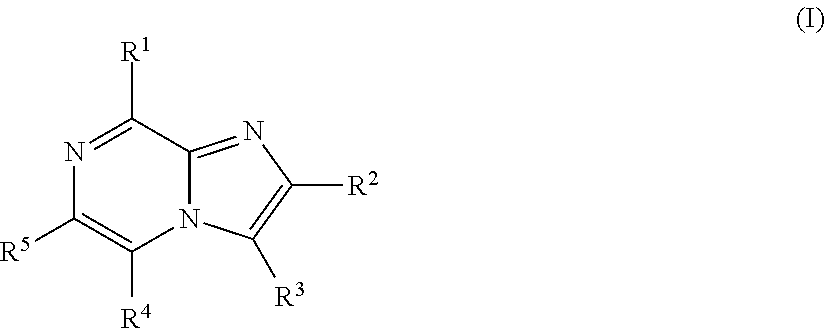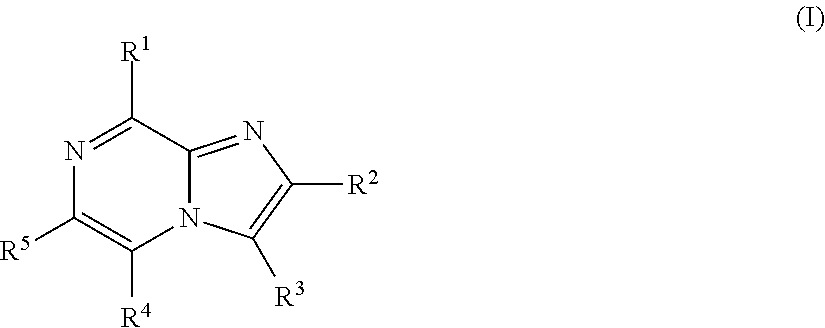Imidazopyrazines for use as kinase inhibitors
a technology of kinase inhibitors and imidazopyrazines, which is applied in the field of pharmaceutically useful compounds, can solve the problems that none of these documents predominantly relate, and achieve the effects of increasing in vivo half-life, facilitating preparation and detection, and reducing the risk of side effects
- Summary
- Abstract
- Description
- Claims
- Application Information
AI Technical Summary
Benefits of technology
Problems solved by technology
Method used
Image
Examples
example b1
Preparation of Final Product 2-01
[0365]
[0366]A mixture of intermediate I-12 (100 mg, 0.282 mmol), 3-hydroxyphenylboronic acid (85 mg, 0.685 mmol), and PdCl2(dppf).DCM (23 mg. 0.028 mmol) in DME (1.2 mL) was added a saturated aqueous solution of sodium carbonate (1 mL). The mixture was heated to 130° C. under microwave irradiation for 3 min. The reaction mixture was cooled, diluted with chloroform, washed with brine. The organic phase was dried (Na2SO4), filtered and the solvent removed in vacuo. The residue was purifired by biotage chromatography with a gradient cyclohexane / EtOAc: from 100% to 50:50. The desired fractions were collected and the solvent evaporated. The resulting solid was crystallised with MeOH to obtain a white solid as final product 2-01 (44 mg, Y: 68% yield).
Preparation of Final Product 2-10
[0367]
[0368]A mixture of intermediate I-18 (200 mg, 0.435 mmol), 3-hydroxyphenylboronic acid (132 mg, 0.985 mmol), and PdCl2(dppf).DCM (36 mg. 0.044 mmol) in DME (1.8 mL) was a...
example b2
Preparation of Final Product 2-21
[0403]
[0404]A suspension of final compound 2-52 (160 mg, 0.5 mmol) in MeOH / NH3 7N was heated in a sealed tube at 90° C. for 16 h. A precipitate appears which was filtered off to obtain 75 mg of the desired product 2-21 as a brown solid (Y: 41%)
Preparation of Final Product 2-77
[0405]
[0406]To a mixture of intermediate I-32 (70 mg, 0.185 mmol) with dry DMF (3 drops) in benzene (2 mL) was added oxalyl chloride (2 equiv, 0.370 mmol, 31 uL). The mixture was stirred at rt for 3 h, then same amount of reagents was added and stirring continued for 1 h. No reaction observed so volatiles were removed under reduced pressure and the residue was dissolved in dioxane (2 mL) and NH3 in dioxane 0.5N (2 mL) was added. The mixture was stirred at it overnight and solvent was evaporated under vacuum. The residue was purified by preparative HPLC affording 3 mg of final product 2-77 (Y: 4%).
example b3
Preparation of Final Product 2-22
[0407]
[0408]Final product 2-21 (50 mg, 0.138 mmol) in POCl3 (2 ml) was heated to reflux for 2 h. The solvent was evaporated in vacuo and the residue was suspended in DCM and Na2SO4 aq. solution. The organic phase was extracted, dried (MgSO4), filtered and evaporated to obtain a light brown solid which was washed with Et2O. The precipitate was filtered and dried to obtain the desired product 2-22 (25 mg, Y: 53%) as a pure solid.
PUM
| Property | Measurement | Unit |
|---|---|---|
| Digital information | aaaaa | aaaaa |
| Mass | aaaaa | aaaaa |
| Mass | aaaaa | aaaaa |
Abstract
Description
Claims
Application Information
 Login to View More
Login to View More - R&D Engineer
- R&D Manager
- IP Professional
- Industry Leading Data Capabilities
- Powerful AI technology
- Patent DNA Extraction
Browse by: Latest US Patents, China's latest patents, Technical Efficacy Thesaurus, Application Domain, Technology Topic, Popular Technical Reports.
© 2024 PatSnap. All rights reserved.Legal|Privacy policy|Modern Slavery Act Transparency Statement|Sitemap|About US| Contact US: help@patsnap.com










